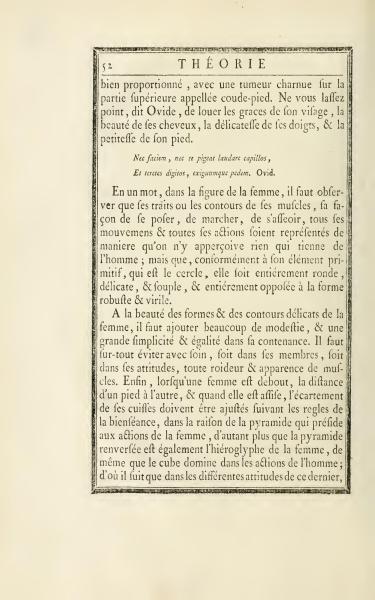Theory
Well proportioned, with a fleshy swelling on the upper part called the "instep." Do not tire, says Ovid, of praising the graces of her face, the beauty of her hair, the delicacy of her fingers, and the smallness of her foot.
Nor should you be tired of praising her face, her hair, her slender fingers, and her tiny foot. Ovid.
In short, in the figure of the woman, it is necessary to observe that her features or the contours of her muscles, her way of positioning herself, walking, sitting, all her movements and actions should be represented in a way that nothing masculine is perceived; but that, according to her primitive element, which is the circle, she is entirely round, delicate, and supple, and entirely opposite to a robust and virile form.
To the beauty of the forms and the delicate contours of the woman, one must add a lot of modesty, and great simplicity and equality in her demeanor. It is especially necessary to avoid, whether in her limbs or postures, any stiffness or appearance of muscles. Finally, when a woman stands, the distance from one foot to the other, and when she is seated, the spread of her thighs must be adjusted according to the rules of propriety, based on the reason of the pyramid that governs the actions of the woman, especially since the inverted pyramid is also the hieroglyph of the woman, just as the cube dominates the actions of the man; thus it follows in the different postures of the latter.
Translation Notes
1. Cou-de-pied: A term for the upper part of the foot, often referred to in dance and anatomy.
2. Bienseance: A concept referring to propriety or proper manners.
3. Hieroglyph: Used here metaphorically, indicating symbolic meanings assigned to forms.
The text discusses the ideal representations of female form, emphasizing roundness, delicacy, and suppleness as opposed to masculine robustness. It highlights the importance of modesty and proper demeanor and suggests that posture should follow the symbolism of shapes like the pyramid and circle. The ideas draw on both artistic and philosophical interpretations of form in the context of beauty and propriety.
